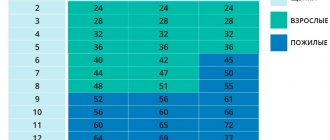Although dogs live shorter lives than their owners, just like people, they go through various stages of life, including childhood, adolescence, maturity and old age. And understanding what age a pet is by human standards will help you understand it, determine its needs and find an approach to raising it. But, since there are different approaches to how to recalculate dog years to human age, it is necessary to determine the option that is closest to reality.
How to calculate a dog's age - a modern approach
Converting dog years to human ages is a complex task that requires taking into account many factors. It is impossible to fully cover all aspects of development, physiological characteristics in accordance with the breed and living conditions of pets. Therefore, for calculations, data obtained from companies insuring pets and from veterinary clinics is used, plus statistics from examinations carried out in kennel clubs are collected. Based on this, in 2022, a group of scientists from America decided to conduct their own research, according to which they were able to create a formula that allows them to calculate dog years:
Pet's age in human years = 16 × ln(dog's age) + 31,
where ln is the natural logarithm
Logarithmic function for epigenetic translation from dog age (x-axis) to human age (y-axis). Illustration from the study Quantitative translation of dog-to-human aging by conserved remodeling of epigenetic networks
A more simplified approach is offered by the American Veterinary Medical Association: their general guidelines state that the age of pets by human standards can be calculated as follows:
- The 1st year of a dog’s life is equal to 15 human years.
- In the 2nd year, the pet lives 9 human years.
- Each subsequent year is equivalent to 5 human years.
Method number 4. By the eyes
You can try to determine the age of a dog by looking into its eyes.
- The young dog has a clear, clean look with cunning. Eye problems are rare, especially with proper care.
- In an older dog, the eyes become “cloudy” and more deeply set. The incidence of eye diseases is very high.
All of the listed signs are best assessed together, then the age can be determined with an accuracy of up to a year. Unfortunately, it is not possible to find out more accurately how old and how many months a dog is.
Tell me if your pets are showing signs of aging as described in this article. Or do they remain the same until old age as in their youth?
How was the age of dogs calculated in the past?
For a long time, people were interested in how to understand how old a dog is in comparison with them. Therefore, research was carried out and assumptions were made. Some theories were close to reality, others were as far away as possible. But each should be considered separately.
1 dog year = 7 human years
Initially, it was decided that the age of dogs was calculated simply - 1 human year is equal to 7 dog years. This judgment arose by dividing the average life expectancy of a person, taken as 70 years, by the average life expectancy of pets, taken as 10-12 years.
The formula was subject to serious criticism, since it assumed that by the end of the first year of life, a furry pet is developed at the level of a 7-year-old child, and by the end of the second, it reaches the level of a 14-year-old teenager. But since a one-year-old dog is considered an adult, since the dog is capable of reproducing, and the human body matures up to 14-15 years, the calculation lost its meaning and became erroneous.
The theory of the French veterinarian Lebeau
The Frenchman Lebeau, who worked as a veterinarian, in 1950, conducted a series of studies on the physiology of dogs and proposed a new approach to calculation. In its version, dog years are correlated not only with the overall length of life, but also with the physical and psycho-emotional development of the pet. Lebeau suggested that it would be possible to translate dog ages according to humans as follows:
- 1 year is equivalent to 15 years.
- 2 years corresponds to 24 years.
- 3 years are equivalent to 28 years and then 4 human years are added every year.
That is, as a result of his research, from the age of 2, four-legged family members lived 1 year as 4 years of a person. But since Lebeau did not take into account the individual characteristics of pets and the conditions in which they were kept in his studies, such a calculation was considered suitable only for pets of small breeds.
Swiss biologist Kleiber's law
Max Kleiber, Swiss biologist
Swiss scientist Max Kleiber, being a biochemist by profession, was able to create the most accurate theory. In his research, he was guided by a previously discovered law that spoke about metabolic processes in the animal body, and through a series of experiments he was able to find out that large animals live longer. But this system works in the opposite way in the case of dogs. Based on his work, we can say that the older dogs become, the greater the difference between their biological age and the corresponding human years.
This trend can be illustrated by the Pekingese and Labrador. A Pekingese turns 15 years old in one year, 23 years old in 2 years, and 36 years old in 5 years. And in the case of a Labrador, in one year it is comparable to a 14-year-old teenager, in 2 years the Labrador reaches 29 years old by human standards, and in 5 years it reaches 45 years.
But there are also exceptions. It is known that the body of small breed dogs contains substances that help slow down the aging process, which increases the years of life.
Kleiber's Law
Kleiber's Law is a law in biochemistry that defines and explains the relationship between metabolic rate and body weight. The lower the body weight of the organism, the higher the basal metabolic rate and the shorter the life expectancy.
Within the subspecies, this law has the opposite meaning. The reason for this reverse development is unknown, but it has been established that the smaller the size, the longer the life expectancy. Statistically, this can be represented by data on average life expectancy depending on weight category:
- Large breeds (e.g. Labrador, Mastiff, Shepherd) – 12 years.
- Medium (bulldog, setter) – 14 years.
- Small (for example, Chihuahua) - 16 years.
Thus, since the average person lives 75 years, 75 human years corresponds to 12–16 dog years.
Dog age to human age
You can determine how old a dog is in human years by taking into account which weight group the pet belongs to:
- Small – 9 kg or less.
- Average – 10-21 kg.
- Large – 22-45 kg.
- Huge - 46 kg or more.
1 year
By human standards, the first dog year for a small, medium and large dog is equivalent to 15 years, and for a large dog - to 12.
2 years
At 2 years, the ratio of the age of a dog to a person for small, medium and large pets is equal to 24 years, for large ones - to 22.
3 years
Having reached 3 years old, a small, medium and large dog is developed at the level of a 28-year-old person, and a huge one - at the level of a 31-year-old person.
4 years
Having lived for 4 years, a small, medium in weight and large dog is considered 32 years old by human standards, a huge one is 38 years old.
5 years
At the onset of the 5th year of life, the dog years of a small, medium and large pet in human years are equal to 36, and for a large pet to 45.
6 years
Starting at 6 years of age, a difference in human years is present in all dogs:
- small – 40 years;
- average – 42 years;
- large – 45 years;
- huge - 49 years old.
By the age of 6, a small furry companion reaches 40 human years, a medium one - 42, a large one - 45, a huge one - 49.
7 years
At the age of 7, a four-legged family friend is considered to be developed by analogy with a person:
- small – 44,
- average – 47,
- large – 50,
- huge – 56.
8 years
By the age of 8, the psychological and physical age of the pet, by human standards, approaches:
- small breeds – 48;
- representatives of medium breeds – 51;
- large – 55;
- huge – 64.
9 years
At 9 years old, a small dog is considered to have reached 52 human years, a medium one - 56, a large one - 61, and a huge one - 71.
10 years
From the age of 10, dog years in small breeds approach 56 human years, medium - 60, large - 66, huge - 79.
11 years
Having lived like a dog for 11 years, the small four-legged friend turns about 60 years old, the medium one - 65, the big one - 72, the huge one - 86.
12 years
By the time a dog turns 12 years old, the psychological and physical condition of a dog of small breeds is translated into 64 human years, medium - 69, large - 77, huge - 93.
13 years
From 13 years of age, breeders can consider a small dog to have grown to 68 years of age. An average pet reaches 74 years, a large one - 82, a huge one - 100.
14 years
By the time a dog turns 14 years old, the dog years of a small dog, by analogy with people, are equal to 72 years, a medium one - 78, a large one - 88, a huge one - 100.
15 years
At the age of 15, a small pet is considered to have reached 76 human years, a medium one - 83, a large one - 93, and a huge one - 114.
16 years
Having reached 16 years of age, small dogs are compared to an 80-year-old person, medium - 87, large - 99, huge - 121.
17 years
At 17 years old, the dog age of representatives of small breeds is considered to be equal to 84 human years, medium - 92, large - 104, huge - 128.
18 years
By the onset of the 18th year of life, the human age for a small breed is equal to 88 years, for a medium breed - 96, for a large one - 110, for a huge one - 135.
Life expectancy and age groups
Dogs live on average from 9 to 20 years. This factor largely depends on the size of the animal. Small breed dogs usually live to older ages than their larger counterparts. Giant dogs such as mastiffs, Great Danes and St. Bernards have the shortest life cycle. There are three main groups into which all dogs can be roughly divided:
- puppy;
- young animals;
- adult representative of the species.
Technically, a dog can be considered a puppy for the first two months of its life
From the moment of birth until 8 weeks, the animal is considered to be a puppy. From this age until reaching 18 months - young animals. Dogs over this age are considered adults.
What dog breeds live the longest?
The top 5 breeds with the longest life expectancy include:
- The New Guinea Singing Dog is a population discovered in the mid-20s. The breed is still being studied and parameters for classification are being determined, but the life expectancy turned out to be impressive - 18 years.
New Guinea singing dog
- The Chihuahua is a small breed native to Mexico. Being a companion dog and being one of the smallest breeds, these pets have an amazing lifespan of 17 years.
Chihuahua
- The toy poodle is a decorative German breed that resembles a charming plush toy and has a lot of positive qualities. This includes a life expectancy of up to 16 years.
Poodle
- The Jack Russell Terrier is a breed bred in Great Britain, intended for hunting. Now, regardless of whether the pet is involved in the original activity or plays the role of a furry companion, its life can last up to 16 years.
Jack Russell Terrier
- The cockapoo is a designer cross between a cocker spaniel and a poodle, also called a cockerpoo or spoodle. As a result of selection, these fluffy beauties have acquired good health and can live 16 years.
Cockapoo
Main causes of premature death
The causes of premature death can be congenital defects, but also acquired diseases.
Congenital diseases:
- Cryptorchidism and disorder of sexual dimorphism;
- Incorrect body proportions and height;
- Irregular tail shape (docked, carried over the back or ring-shaped);
- Incorrect muzzle shape (too short/long or blunt);
- Droopy or soft ears, malocclusion;
- Coat problems;
- Weak pigmentation and blue eyes;
- Excessive excitability, cowardice or lethargy.
But there are also acquired health problems caused by improper care:
- Insufficient amount of physical and intellectual activity;
- Improper maintenance (the dog is constantly in a cramped room - an apartment or an enclosure);
- Incorrect selection of food or diet in which the dog does not receive enough vitamins;
- The dog was not allowed to recover from the birth and was bred again;
- Dangerous work with risk to life;
- Physical activity when the dog has not yet recovered from any wounds or injuries.
What dog breeds live the shortest?
Pets with the shortest life expectancy include:
- The Dogue de Bordeaux is a strong and impressive pet, originally from France, with a calm and confident character. But, despite a lot of positive qualities, this breed lives for 5-8 years.
Dogue de Bordeaux
- The Great Dane is a giant beauty bred in Germany and is rightfully considered a true aristocrat. His appearance and character are suitable for raising a confident and devoted family pet, but he lives for 6-8 years.
German dog
- The Bernese Mountain Dog is a herding breed originally from Switzerland and has a number of universal qualities. But its life expectancy is within 6-8 years.
Bernese Mountain Dog
- The Irish Wolfhound is a calm and impressively sized dog from Ireland bred to hunt large game. Despite the fact that these dogs are now rarely involved in the original business, their health and growth rate lead to a life expectancy of 6-10 years.
Irish Wolfhound
- Neapolitan Mastiff - brutal beauties originally from Italy have a long history and many positive qualities. But they live 7-9 years.
Neapolitan Mastiff
How many live on the street and at home?
German Shepherds that live outdoors have a longer lifespan than those that live indoors.
This is due to the characteristics of the breed itself. Germans need physical activity, in which it is difficult and impossible to limit them, as well as mental activity, which manifests itself in training.
If you take away these aspects of your dog's life, it will have a negative impact on their physical and mental functioning.
The dog may become aggressive, its muscles will begin to weaken, and it will no longer be able not only to stand up for itself, but also to protect its owner.
If a German Shepherd is constantly kept in an enclosure on the street, this will lead to the same consequences.
Many dog breeds, on the contrary, feel more comfortable indoors, but the German Shepherd is not one of them. It is better and healthier for her to be outside - she is not afraid of rain and cold because of her dense undercoat and good coat.
Therefore, we can say with confidence that dogs living in the courtyard of a private house live much longer than those who have to huddle in an apartment.
But this does not mean at all that a German Shepherd cannot live indoors . Just provide her with the right amount of physical and mental stress.
Why do small dogs live longer than big ones?
The phenomenon that small breeds have a longer life expectancy than large dogs has long raised questions among scientists and dog handlers. Evolutionary biologist at the University of Göttingen in Germany, Cornelia Kraus, argues that big dogs are going through the aging process at an accelerated rate. Scientists believe that every 2 kg of body weight reduces the life expectancy of a four-legged pet by about a month. And, despite the fact that a clear reason for this has not been determined, Kraus has several assumptions. These include the fact that larger individuals succumb to age-related pathologies earlier, and that accelerated growth rates increase the likelihood of abnormal cell growth, which affects the quality of health.
The oldest living dog is the miniature dachshund Fanny, who lives in Japan. The baby was born on 05/27/1999 and at the time of checking the record by a representative of the Guinness Book of Records (11/12/2020) she was 21 years and 169 days old.
Miniature dachshund Fanny is the oldest living dog (21 years and 169 days).
Currently, canine gerontology is an actively developing field of science. Therefore, scientists continue to work, and plan to further find out what the relationship is between the size and lifespan of a dog. They also set themselves the goal of slowing down the aging of pets and promoting longevity while maintaining good health.
Long-lived dogs from the Guinness Book of Records
More than 20 long-lived dogs are registered in the Guinness Book of Records, whose age is documented.
The title of the Oldest Dog in the World still belongs to the Australian Cattle Dog (Australian Heeler) named Bluey. The dog lived for almost 29.5 years and this record has not yet been officially broken!
Bluey is the oldest dog ever living Photo: wikipedia.org
| Nickname | Years of life | Age | Breed |
| Bluey | 1910-1939 | 29 years 160 days | Australian Cattle Dog |
| Butch | 1975-2003 | ≥28 years 0 days | Beagle |
| Taffy | 1975-2003 | 27 years 211 days | Welsh Sheepdog |
| Snookie | 1991-2018 | ≥27 years 284 days | Pug |
| Bramble | 1975-2003 | 27 years 211 days | Border Collie |
| Adjutant | 1936-1963 | 27 years 98 days | Labrador Retriever |
| Buksi | 1990-2017 | 27 years | Cur |
| Pusuke | 1985-2011 | 26 years 248 days | Shiba Inu mix |
| Sugar | 1952-1977 | 24 years 360 days | Unknown |
| Piccolo | 1987-2010 | 23 years 86 days | Pug |
| Funny | 1999-present day | 21 years 169 days | Miniature Dachshund |
| Chanel | 1988-2009 | 21 years 114 days | Dachshund |
| Otto | 1989-2010 | 20 years 334 days | Mixed dachshund and terrier |
| Seamus | 1993-2014 | 20 years 298 days | toy poodle |
| Sotirakis | 1993-2014 | 20 years 280 days | Cur |
| Megabyte | 1993-2014 | 20 years 265 days | Chihuahua |
| Murzyn | 2000-present day | 21 years, 227 days | Cur |
| Winston Rha | 1992-2013 | 20 years 154 days | Schnoodle (a cross between a schnauzer and a poodle) |
| Lady | 1999-2019 | 20 years 130 days | Dachshund |
| Willie | 1994-2014 | 20 years 106 days | Jack Russell Terrier |
| Scolly | 1993-2013 | 20 years 33 days | Dachshund |
According to wikipedia.org
Scientists studied the phenomenon of the Australian heeler Bluey in 2011, but after testing 100 dogs, they came to the conclusion that Bluey’s longevity is rather an exception to the rule, because The average lifespan of the Australian Cattle Dogs studied was 13.5 years (±2 years).











